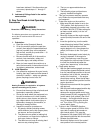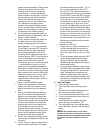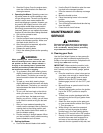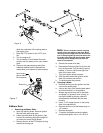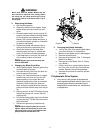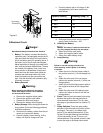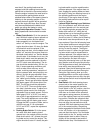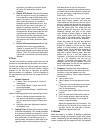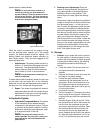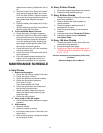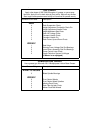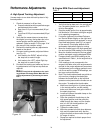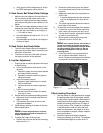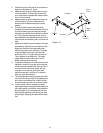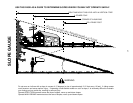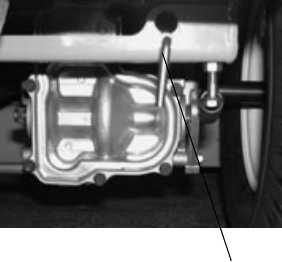
21
system locks the traction wheels.
Note:
To move the mower forward or in
reverse by pushing, you must release the
dynamic braking. Locate the release levers at
the rear of the machine. Pull them toward the
rear and lower the wide area of the rod into the
keyhole slot. (See photo below)
.
When the mower is parked with the engine running
and the steering levers opened out in the neutral
position, the parking brakes should be applied. The
parking brakes are gear/pawl brakes mounted on
each traction wheel. They are both engaged by the
same operating lever.
1.
Adjustments:
The parking brake handle is a
lever in a “j” slot that should engage with mod-
erate force. The parking brakes provide a
positive means to hold a machine stationary
that is similar to “Park” on an automobile.
Note:
The parking brakes normally do not
need to be adjusted.
To adjust either brake individually, loosen the jam nuts
on the cable near the brake arm on the transaxle.
Adjust the nuts so that the brake/pawl comes closer to
the gear, but not in contact with the gear teeth.
2.
Repair:
The mower is equipped with external
gear/pawl brakes and will not normally require
maintenance. If they are not working properly,
please contact your service center.
G. Hydraulic System
1.
Hydrostatic Pumps and Motors:
The pumps
in the transaxles are the hardest-working
components in the hydraulic system. They are
in operation all the time the engine is running.
Because of extremely close tolerances, wear
is an important factor in their life.
Note:
The pumps and motors are not
owner-repairable. If a pump fails, contact your
Cub Cadet dealer. Do not disassemble the
pump/motors.
2.
Steering Lever Adjustments:
Place the
mower on level ground with the engine run-
ning, parking brake off and steering levers
opened out to the neutral position. If the
mower begins to creep, adjust the steering
levers.
If the mower creeps, first determine whether it
creeps to the right or left side and which direc-
tion the mower moves — to the front or the
rear. To make the adjustment, place the steer-
ing levers in the opened-out neutral position
and set the parking brake, shutoff the engine,
take the key from the ignition switch and pivot
the seat forward. If the mower creeps to the
right, you will adjust the linkage on the left
side of the mower and vice-versa. Loosen the
jam nut which prevents the linkage rod from
turning. If the mower creeps forward, turn the
linkage rod counterclockwise. If the mower
creeps backward, turn the linkage rod clock-
wise. Then tighten the jam nuts.
H. Storage
1.
General:
If your mower will not be in service
for a few months, it should be stored in a dry
location that is not subject to drastic changes
in temperature. Before storing, the following
maintenance procedures should be per-
formed.
a. Clean the mower. The entire tractor and
cutting deck should be washed and
cleaned.
b. Sharpen the blades so that the mower will
be ready to use when needed.
c. Protect the metal surfaces. Repair
scratches with the appropriate touch-up
spray paint. Brush a rust preventive oil on
any unpainted surfaces including the pul-
leys and blades. (Be careful not to get any
oil on the drive belts.)
d. Lubricate the mower.
e. Drain the engine oil. The engine should be
warm so that all the oil drains. Replace the
engine oil filter and refill the crankcase with
fresh oil.
f. Gasoline Engine: Drain all the fuel. Close
the fuel tank shutoff valve. Disconnect the
fuel line from the carburetor and put the
end into an approved fuel container. Open
the fuel tank shutoff valve and drain the
fuel tank and line into the approved con-
tainer. Replace the fuel line on the carbure-
tor. Start the engine and allow it to run out
of fuel. This will prevent gum and varnish
Hydro Release Valve



